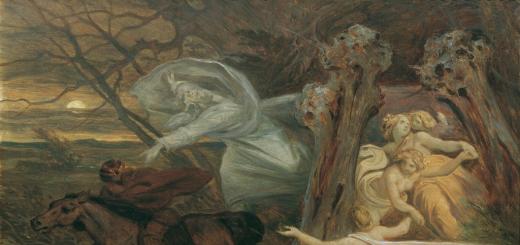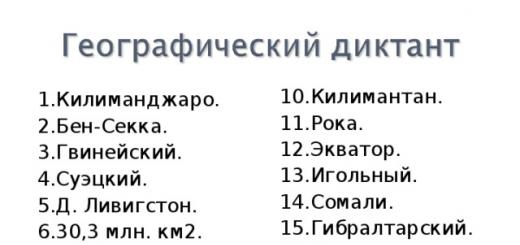This is one of A. A. Fet’s most beautiful poems about love, it was published in 1843 and caused a great resonance among contemporary poets. Interest in Fet's work was caused by his writing style, since he violated Pushkin's style of versification, which was recognized as the standard. In his poems there is no extreme precision in combinations of words, they are closer to living speech, and therefore their images are more vivid and expressive. An example of this is the first line of the poem.
The poem is filled with light and joy. The lyrical hero shares his feelings, talking about a wonderful morning and his feelings. This story is harmonious. For Fet, the most important thing in the poem was the ending. That is why the story of the lyrical hero ends with a song - the quintessence of joy.
Among the poetic devices used in the poem, one can note the personification “the forest woke up... roused itself”, the epithets “hot light”, “spring thirst”. The metaphor “breathes with joy” used by Fet is interesting; instead of the breath of the spring breeze, the lyrical hero feels a feeling of joy that surrounds and fills him from all sides. The poem uses parallelism lyrically, because The first half of the poem describes the state of nature, the last two - the state of the hero’s soul.
The harmony of the composition is achieved through repetition; three out of four stanzas begin with the word “tell”, this enhances the artistic impact on the reader. The repetitions sound like a refrain and give the work a melodious quality; women’s rhymes also contribute to this. The unstressed endings of the lines give it even greater musicality.
Option 2
At all times, in all historical eras of the development of society, sublime and romantic feelings inspire and elevate a person. When love lives in the heart, and the soul is filled with tenderness and affection, a person’s life takes on a completely different meaning. A person becomes the happiest, most romantic and friendly towards everyone around him. Each new day brings new sensations, experiences that evoke delight and admiration from the beautiful moments of what was seen, heard or experienced.
Reading Afanasy Fet’s poem “I came to you with greetings,” it’s as if you are plunging into an atmosphere of romanticism and serenity. Once upon a time, this author was the most lyrical poet in Russian literature, who was characterized by sublime feelings, a “soft” and pure soul. European heredity played an important role in this for the future poet, since his parents were Germans by origin. From his mother, Afanasy Fet inherited dreaminess and the ability to see beauty around him. From his father, the future poet received a thirst for knowledge, an interest in everything new and unknown, as well as a sharp mind. Thanks to all these qualities together, the author was able to achieve significant success in literary activity.
When the poet was 23 years old, and this is the age suitable for love, he, without hiding his feelings, wrote the poem “I came to you with greetings.” At that time, he had a beloved girl, to whom the author dedicated this poem, filled with a feeling of lightness and immense happiness.
In it, the poet, comparing his feelings with a beautiful spring morning, filled with tenderness, the desire to warm a new day, describes a meeting with his beloved. It is no coincidence that the spring time in the poem is described, because this is the time of love, the awakening of feelings. Just as nature wakes up from its winter sleep, so human feelings come to life and give free rein to emotions. The author came to his beloved early in the morning to wish her good morning and, with the same passion as yesterday, again tell her about his love. The poet is ready to talk about his sincere and tender feelings not only to his beloved girl, but to all of nature, the entire world around him. Conveying his romantic mood, he says that his soul is ready to serve happiness and his chosen one. The author does not have enough words to convey his feelings, so he is even ready to sing, despite the fact that the words have not yet matured or taken shape.
Analysis of the poem I came to you with greetings Feta No. 3
Afanasy Fet is a very talented person, maybe because he has very romantic and bright poems, because his life was very rich at first, because love is precisely that feeling of richness that is given to us in a minimal chance - once in a lifetime. Not everyone will be able to take full advantage of this chance. Fet turned out to be not exactly the favorite of fate, because his beloved died, burned, after some time, he abandoned her, having nevertheless married, despite his feelings for her, to another woman. Afanasy Fet regretted it for a long time - or rather, all his life.
But it is precisely this poem entitled “I came to you with greetings...” that shows that not everything has perished in this man, that is, some bright, and even more, feelings have been preserved, and not just the pain and disappointment that he showed in many of his other poems. Fet turned out to be capable of much more in his time - joyful feelings from the realization that he lives and not everything is so bad. But at the same time, he constantly remembers his mistake, and remembers his beloved, whom he loved all his life, even after her such a tragic death.
Fet’s poem “I came to you with greetings...” is a very joyful and bright work of his age. In this work, the writer seems to emphasize the great and very important significance of days, or rather, every day in our lives. After all, we live, breathe, walk with our own feet, feel and, most importantly, love! We, people, have this opportunity, and we need to use it one hundred percent. Fet seems to be telling a person who has just woken up that the sun has risen, that everything around is light and warm, the birds are singing, and everything around is turning green. Beautiful weather, during which you simply cannot sit at home, cooped up. You need to rest, breathe and enjoy, otherwise your whole life will pass like this.
Fet is a person, despite everything, no matter what happened in his life, who is positive and joyful, and also inspired. Inspired by the simple thought of life and eternal love, which does not go out, and which will pass even through death. This poem really helps to simply enjoy life, love and remember the great power of nature, which can change a person’s mood for the good. This work is epic, it is not too large in size, and consists of several stanzas. The lines are rhymed, which creates the effect of quick reading and pleasant listening.
Option 4
One of the most famous poems by A.A. Feta. It is a hymn to pure and bright youthful love. The poet skillfully plays with words, making his work ring with the mood of a spring morning and the hero’s vivid feelings.
The poem consists of four stanzas, the first two describe nature, the awakening morning forest, the second - the emotional state of the lyrical hero heading to his beloved. The author uses the technique of psychological parallelism, keeping the stanzas in strict accordance with each other. This makes it easier for the reader to relate the description of the character’s nature and emotions.
The poet shows the spring forest in the perception of his lyrical hero. This is a young and loving young man, just like Fet when he composed this poem. His feelings are pure and bright, literally giving him wings. After all, the hero is ready to see his beloved constantly, and is looking for various reasons for meetings. And the coming of morning is already enough reason to see each other.
The words used by the poet in describing the forest make the reader not only see it, but also hear the light rustling of the leaves, feel the warm rays of the sun breaking through the branches of the trees. The quiet night forest was filled with the energy of the morning, just like the hero, overwhelmed with feelings, because of them he becomes so energetic and active.
The poet reveals all the beauty of youth. The character is happy and carefree. He is definitely confident in his feelings, which inspires him and gives him strength. He is able to embrace the whole world. And no clouds of doubt visit him. There is no need to hide or curb the impulse of love.
Undoubtedly, in this poem you can see all the facets of Fet’s lyrical talent. He chooses words so subtly and precisely to express his thoughts. In contrast to the eternity of the theme, the dynamics of the narrative are felt. It emphasizes the transience of the moment, even though it is so bright and happy. It is for this ability to capture the endless beauty of the moment that we love Fet’s work.
Analysis of the poem I came to you with greetings according to plan
You might be interested
- Analysis of the poem by Antony Bryusov
Bryusov's poem Antony first appeared in print in April 1905. This poem touches on topics of great importance for Bryusov.
- Analysis of the poem Don't say, my friend: She will forget me Feta
Fet always kept his personal life away from the eyes of the people around him. His love lyrics are an integral part of his work, but none of the poems has a specific addressee.
- Analysis of the poem We live beneath us without sensing the country of Mandelstam
Mandelstam's most famous poems were written in the 1930s. During those unprecedented changes, many people were silent and afraid to tell the truth and express their opinions. But one unique work of a talented poet had
- Analysis of the poem by Chara Yesenin
Isolation from nature is characteristic of a significant part of urban residents, but Yesenin was from the village and was always distinguished not just by a sense of nature, but by a sense of true unity with all living things
- Analysis of Lermontov's poem Angel 7, 9th grade
M.Yu. Lermontov wrote the poem “Angel” at the age of sixteen. The plot of the work is based on a lullaby that Maria Mikhailovna, the writer’s mother, sang to her son.
1) History of creation. The poem “I came to you with greetings” was written by the poet in 1843 and published in the same year in the magazine “Otechestvennye zapiski” as a title.
2) Topic. The poem is an appeal to the beloved. It intertwines the themes of nature and love - two inseparable themes in Fet’s work.
3) Main idea.
The main idea of the poem is to convey the mood, the mental state that a person experiences on a clear sunny morning.
4) Composition. Compositionally, the poem is divided by the author into four stanzas-quatrains. According to the semantic component, the poem can be divided into two parts. In the first two stanzas, the author describes the change in nature at sunrise:
Tell me that the forest has woken up,
All woke up, every branch...
In the final two stanzas, Fet describes his emotions, his state of mind:
Tell me that from everywhere
I feel joyful...
5)Image analysis. This masterpiece of landscape lyricism has two central images: awakening nature and a young man who has known love.
Fet's nature is radiant; she is not sad or gloomy, she is all glowing under the rays of the rising sun:
What is it with hot light
The sheets fluttered...
Fet’s forest, like a person, wakes up and moves. All nature is enlivened, filled with light and warmth.
The young man is in the same mood as nature. He is delighted with this sun holiday. All this encourages him to come to his beloved and devote himself entirely to her:
That the soul is still happiness
And I'm ready to serve you...
The young man is impressed by the girl, nature, and this inspires him with fun and joy, which he is going to throw out in a song that is already ripening.
6) Rhyme, size, syntax. The rhyme is cross. The poetic meter is trochaic tetrameter. The poem is very melodic, and although there are no exclamations, it seems to me that it should be read in a sublime tone. The author does not use difficult vocabulary, as it is inappropriate here. This poem is written in the simplest language that even a child can understand its meaning.
The syntactic feature is that the poem is written in one complex sentence, which gives integrity to the work.
8) My opinion. This bright poem is filled with the joy of life, childish naivety, purity - all these feelings are conveyed to me when reading the poem. Reading these lines, I forget about my problems and I just want to admire the world around me, I want to sing and love. In my opinion, this is one of the brightest, brightest and most amazing poems I have ever heard. Thanks to this poem-story, I understood why Fet is called the poet of “pure art.”
Updated: 2017-09-28
Attention!
Thank you for your attention.
If you notice an error or typo, highlight the text and click Ctrl+Enter.
By doing so, you will provide invaluable benefit to the project and other readers.
Analysis of the poem
Afanasy Afanasyevich Fet:
Completed by: Elena Molchanova
11 "A" class
Schools GBOU Secondary School No. 276
Checked by: Meshkova Elena Anatolyevna
“I came to you with greetings, to tell you...”
I came to you with greetings,
Tell me that the sun has risen
What is it with hot light
The sheets began to flutter;
Tell me that the forest has woken up,
All woke up, every branch,
Every bird was startled
And full of thirst in spring;
Tell me that with the same passion,
Like yesterday, I came again,
That the soul is still the same happiness
And I’m ready to serve you;
Tell me that from everywhere
It blows over me with joy,
That I don’t know myself that I will
Sing - but only the song is ripening.
The work of Afanasy Afanasyevich Fet (1820-1892) was distinguished by its originality and bold flight of imagination. Being by nature a rather gloomy person, rational in affairs, conservative in beliefs, Fet appears before us as a poet praising the beauty of nature and human feelings. Many critics have often noticed that Fet's poems are not as simple as they may seem at first glance. But in order to understand the work of Afanasy Afanasyevich, you need to learn to perceive it.
My favorite poem is “I came to you with greetings...”. This poetic masterpiece has been associated with the beauty of Fetov’s creations since his youth.
The poem was first published in the magazine “Otechestvennye zapiski” in 1843, in the seventh issue. The main theme of the poem is love. And even though the theme itself is old and hackneyed, the work is distinguished by its novelty and freshness. And many of Fet’s contemporaries testified to the extraordinary methods of writing poetic texts.
The very beginning of the poem is already unusual, if only because the poets of that time adhered to the Pushkin tradition of versification, which required extreme precision in words and combinations of words. Line from text:
I came to you with greetings, to tell you...
It is inaccurate and not even entirely “correct”. Critics of the time saw Fet as a daring and courageous poet. Fet knew about the inaccuracies of his poetic words, about their closeness to living, and therefore more vivid and expressive speech. The poet jokingly called his works poems “in a disheveled state.”
The not entirely correct and seemingly sloppy expressions of Fetov’s poems create bizarre, unusually new images. Already the first words of the poem “I came to you with greetings...”, so seemingly random and absurd, create the organic naturalness of living speech. The feeling of improvisation makes the beginning of a poetic text even easier and more accessible. The moment of improvisation can be seen in the last words of the poem:
I don’t know what I will be
Sing - but only the song is ripening.
Reading this poem by Fet, it sometimes seems to me that the word has some special property in Afanasy Afanasyevich, which, with all its breadth and instability, gives rise to various associations in thoughts. This can only be compared to a musical image.
At the beginning of Fetov's poem, some words sound especially vivid.
In the first stanza it is: “hello”, “sun”, “light”, “trembling leaves”. Their emotional meaning is close to each other.
Based on the associations they evoke, they speak of strong feelings - joy, happiness, love. Resembling a musical chord that gradually increases its sound, harmony is perceived in the sound and verbal series. An important advantage of any poetic text is its integrity. Here it manifests itself with amazing vividness. In the poem “I came to you with greetings..” both the harmony of objects and the harmony of tone are noticeable. In one movement there are objects of the external world and the feelings of the hero.
Numerous repetitions in the poem also contribute to the integrity of the composition of the work. Repetitions seem to hold the words together in this poem. Repetition achieves a harmonious, holistic movement of sounds and words. This is called artistic influence on the reader.
For example, the verb “tell” is the main anchor word in a poem, giving the text a unified sense of integrity. This word is noticeable in the second verse of the first stanza and in the first verse of all subsequent stanzas: “Tell that with the same passion”, “Tell that from everywhere...”. In the text you can also find repetition words: “The forest woke up” - “all woke up”, “every branch - every bird.”
I would also like to note the fact that all the rhymes in the poem are female. This ending with an unstressed syllable gives lingering and musicality.
Fet paid great attention to the ending in his poetic works. Here it can be noted that the lyrical plot ends with a song - the highest point of joy. The song doesn’t even have words yet, but it’s already bursting out.
In conclusion, I would like to note that Fet’s works have been extremely popular for the past century. His poems are like songs, and songs have always existed and came from the very heart, touching the soul of the listener!
Many people will like to read the poem “I came to you with greetings” by Fet Afanasy Afanasyevich. It is very poetic, rhythmic and easy to understand. This poem, written in 1843, seems to be simultaneously addressed to everyone and everyone individually. Some researchers of the poet’s work believe that the lyrics are addressed to the author’s beloved, but who she is has not been established. We can partly agree with this opinion, because it is difficult to imagine that not a single girl touched the poet’s soul at a young age. But the statement also has the right to exist that a poem is simply an appeal to any loved one (not necessarily to a loved one) or a skillfully composed lyrical story inspired by the arrival of spring.
To better prepare for expressive reading or writing an essay in a literature lesson in grade 5, the text of Fet’s poem “I came to you with greetings” is worth downloading or learning online in full on our website.
I came to you with greetings,
Tell me that the sun has risen
What is it with hot light
The sheets began to flutter;
Tell me that the forest has woken up,
All woke up, every branch,
Every bird was startled
And full of thirst in spring;
Tell me that with the same passion,
Like yesterday, I came again,
That the soul is still the same happiness
And I’m ready to serve you;
Tell me that from everywhere
It blows over me with joy,
That I don’t know myself that I will
Sing - but only the song is ripening.
Afanasy Afanasyevich Fet is a rather mysterious person, difficult to understand. His life path cannot in any way be called smooth, mediocre or mediocre, as well as his creativity. The secrets that shrouded Fet as a person and a poet go back to the very beginning, which raised a lot of questions among both art critics and ordinary poetry lovers. The most surprising thing is that even before Afanasy Afanasyevich, not all the doors to the past related to the origin of the surname given to him at birth were open.
Fet as a controversial personality in art and life
The life of the Russian lyricist was accompanied by love mysteries, detective twists and turns, which one day he would call the plots of his complex novel. The spirit of adventure was present in the writer’s life before his birth. Afanasy's mother, being pregnant, arranges an escape with her lover and leaves her legal husband, who was the father of her child. At birth, the boy receives the noble surname Shenshin, which belongs to his mother's lover. When the young man turns 14, he suffers a fatal blow: the most important thing in life is taken away - his stepfather's surname, as well as the privileges of the nobility.
At birth, the boy receives the noble surname Shenshin, which belongs to his mother's lover. When the young man turns 14, he suffers a fatal blow: the most important thing in life is taken away - his stepfather's surname, as well as the privileges of the nobility.
After such events, Fet is obsessed with the idea of returning his last name, which defines him as a privileged person in society. As a student, he preferred philosophy, so he entered Moscow University.
During his student years, the poet met such writers as Yakov Polonsky and Vladimir Solovyov. After graduating from university, the poet does not forget about the calling to win the title of nobility and goes to military service.
The love of her life, Maria Lazic, was overtaken by the lyricist at the service; despite her unbridled passion, her beloved does not receive an offer. Afanasy could not imagine his life with a man who did not have material wealth, and ended his relationship with Maria.
The next fatal blow was the death of his beloved. After this, Afanasy, until the end of his life, was unable to calm the sea of pain and loss that was seething in his heart.
The poet idolized the image of his beloved; she was his muse. When the author recalled her death, bitter tears poisoned his soul. Having studied the poet's poems, you can trace the theme of tragic love.
Fet is one of those creative individuals who made “art for art’s sake.” His life path, where he sought to gain material wealth and married an unattractive but wealthy woman, differed from his creative life.
The lyricist called for his poems to be assessed according to the laws of art, and not to determine what social value they have. The main motives of Afanasy’s creativity are the celebration of the beauty of nature and pure love. The technique of writing Fet's creations is impressionistic. There is no description of the picture as a whole; the author seems to be recalling excerpts from that moment that struck him.
The poet's lyrics are full of associative elements. When a poet chooses an object, it is not its direct meaning that is meant, but what feelings and emotions it evokes. In his poems, Fet used the technique of sound writing, so when read, the text is distinguished by melody and easily fits the notes.
Fet's death occurred after an unsuccessful suicide attempt; he remained in the memory of many as a controversial personality, interest in whom remains to this day.
Analysis of the poem “I came to you with greetings”

The text contains subjects of poetry: song, love and nature. For Fet, the concept of beauty lies in these three nouns, irreplaceable and inseparable. Confirmation of this line:
That I don’t know myself that I will
Sing - but only the song is ripening.
Tell me that with the same passion,
Like yesterday, I came again,
That the soul is still the same happiness
And I’m ready to serve you.
Tell that the forest has woken up
All woke up, every branch,
Every bird was startled
The main elements were words and combinations - “song”, “hello”, “happiness”, “sun”, “trembling of leaves”, “light”. The emotional context of each of these elements has something in common and forms the inspiration of the young man - love, fun, joy.
Fet actively uses features that help present the picture:
Epithets – “spring thirst”, “hot light”;
Personifications - “the forest woke up”, “the sun fluttered across the leaves”;
Metaphors - “the song is ripening”, “the soul is ready to serve happiness”;
Alliteration is the repetition of the sounds “s” and “v”.
Such techniques help to imagine spring awakening, hear the rustling of leaves, feel the wind rushing through the forest.
It should be noted that this is a work of four stanzas, to which the author applied psychological parallelism - a clear correspondence of the stanzas to each other. After reading the first two stanzas, the reader is immersed in a spring morning. The subsequent stanzas tell about the hero’s experiences and his state of mind.
The first quatrain is a description of the sun, which awakened everyone around. Fet uses the epithet “hot”, exalting the role of the sun. In the last line “the sheets trembled,” the author used an associative device, with the help of which the reader can feel all the emotional shades of the text. The second quatrain tells about the moment when the energy of the sun awakened the entire forest. Revival is expressed in the feelings of the lyrical hero, his spring joy.
 The third quatrain is filled with rays of the sun, spring joys with which the lyrical hero is charged.
The third quatrain is filled with rays of the sun, spring joys with which the lyrical hero is charged.
The final quatrain, like the last strokes of the brush, enhances the meaning of the previous stanzas, emphasizes the spiritual joy, the cheerful mood of the hero, and the praise of the song. Fet focuses the reader’s attention precisely on the last words, because they contain the main idea of the poem.
If nature blossoms and awakens, then the state of the surrounding world is transmitted to the human soul. Fet provided the reader with the image of a lyrical hero who feels part of this world, wants to share the best emotions with everyone, and whose heart is full of love.
Features of the poem “I came to you with greetings”
In Afanasy’s lyrics at all times, a special place was occupied by colorful descriptions of words in an unusual meaning for them, as well as the desire to share spiritual joy with the reader. In the work, the reader observes how the words “spring”, “sunshine”, “happiness forms a melody” - all this personifies the soul of the poet, like the song of a young man who is inspired by a feeling of love and joy. The author was also able to choose words that help enhance the spring atmosphere - “fun blows,” “trembles.” The poem consists of only one sentence in order to create the effect of the integrity of the reunification of nature and man. To write the poem, the poet chose a two-syllable trochee, which, in conjunction with feminine rhyme, adds song motifs, hence the musicality and tenderness of the work.
The poem consists of only one sentence in order to create the effect of the integrity of the reunification of nature and man. To write the poem, the poet chose a two-syllable trochee, which, in conjunction with feminine rhyme, adds song motifs, hence the musicality and tenderness of the work.
The work “I came to you with greetings” is a story of harmony of love, spring and man, which exists in one breath, like a light breeze, a certain moment in which you want to stay forever. This poem is a world in which the author is doing well, this is a place where he may not think about the loss of love.
Each line evokes admiration and a desire to comprehend the feeling that the lyrical hero has acquired. Fet gave Russian literature a bright fairy tale about a happy man who enjoys every moment.
When did Afanasy Afanasyevich decide to come with greetings?
The poem became a poetic manifesto for the Russian lyricist, a monologue of an inspired young man to his beloved. This work of art appeared in 1843, when Afanasy was 23 years old. In his work, he conveyed all the tenderness and romanticism of that age. During this period, the young man’s life is still full of the fearlessness of human condemnation and the courage of loving deeds.The work played an important role in Fet’s work. The poet created a masterpiece as a hymn about eternal love, which never fades and is always with the hero. The reader first became acquainted with him in a magazine called “Domestic Notes.” The publication was placed on the first page as a title, and this says a lot. Magazines place in such a place only those materials that they appreciate and consider worthy of publication in the most prominent place. This publication once again emphasized the significance of Fet’s contribution to Russian literature.
Fet is a man with two life stories
 Fet is a conservative in life, who defined happiness as material wealth. He is a lyricist who sang pure love for nature. The world of poetry for Fet was an abstraction from the outside world, problems, and social contradictions.
Fet is a conservative in life, who defined happiness as material wealth. He is a lyricist who sang pure love for nature. The world of poetry for Fet was an abstraction from the outside world, problems, and social contradictions. Despite the fact that as a person he could sympathize with few people, but as a poet he managed to conquer a single human soul with his creation. At the same time, his work was repeatedly criticized, because not everyone likes to read about a bright and beautiful feeling.
Some wanted to see social, topical topics in their poems; this is exactly what the poet avoided. In his world of poetry, he felt comfort, which he was deprived of in real life. He himself lives in the poems of Afanasy Fet, and the masterpiece “I came to you with greetings” is proof of this.










